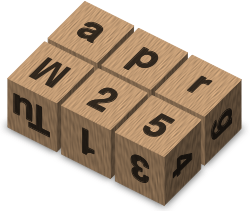Two-cube calendar
A two-cube calendar is a desk calendar consisting of two cubes with faces marked by digits 0 through 9. Each face of each cube is marked with a single digit, and it is possible to arrange the cubes so that any chosen day of the month (from 01, 02, ... through 31) is visible on the two front faces.

| 0 | 0 | Tu | ||||||||
| 3 | 4 | 5 | 6 | 7 | 8 | W | Th | F | ||
| 1 | 1 | Sa | ||||||||
| 2 | 2 | Su | ||||||||
| g | f | l | ||||||||
| j | o | y | v | a | c | t | u | b | ||
| r | n | m | ||||||||
| e | s | p |
A puzzle about the two-cube calendar was described in Gardner's column in Scientific American.[1][2] In the puzzle discussed in Mathematical Circus (1992), two visible faces of one cube have digits 1 and 2 on them, and three visible faces of another cube have digits 3, 4, 5 on them. The cubes are arranged so that their front faces indicate the 25th day of the current month. The problem is to determine digits hidden on the seven invisible faces.[1]
Gardner wrote he saw a two-cube desk calendar in a store window in New York.[1] According to a letter received by Gardner from John S. Singleton (England), Singleton patented the calendar in 1957,[3] but the patent lapsed in 1965.[4][5]
A variation with three cubes providing English abbreviations for the twelve months is discussed in a Scientific American column in December 1977.[6] One solution of this variation allows displaying the first three letters of any month and relies on the fact that lower-case letters u and n and also p and d are inverses of each other.[7]
A number of variations are manufactured and sold as souvenirs, differing in the appearance and the existence of additional bars to set the current month.
See also
References
- Gardner, Mathematical Circus, 1992, p. 186.
- Gary Antonick (2014-10-20). "Remembering Martin Gardner". The New York Times.
- "United Kingdom Patent 831572-A: Improvements in and relating to perpetual calendar device".
- Gardner, Mathematical Circus, 1992, pp. 196-197.
- Stewart, 2010, p. 35.
- Gardner, Mathematical Circus, 1992, p. 197.
- Martin Gardner (1985). The Magic Numbers of Dr. Matrix. Buffalo, N.Y.: Prometheus Books. pp. 210, 308. ISBN 0-87975-281-5. LCCN 84-43183.
Sources
- Martin Gardner (1992). Mathematical Circus. Washington, DC: MAA. pp. 186, 196–197. ISBN 0-88385-506-2. LCCN 92-060996.
- Ian Stewart (2010). "Perpetual Calendar". Professor Stewart's Cabinet of Mathematical Curiosities. Profile Books. pp. 35, 260. ISBN 1847651283.
External links
- Jenny Murray. "The Colossal Book of Short Puzzles and Problems: Review by Jenny Murray". Association of Teachers of Mathematics. Archived from the original on 2015-05-09.